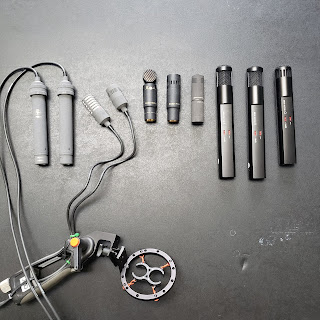MS Mic Shootout

Mics Left to Right: Scheops MK8, MK41, Nevaton MC59-8 MC59-C, Sennheiser MKH8050, MKH30, MKH30, MKH40
Please read the post below. There's a link to the audio files at the bottom of the post but they need context to make sense.
Back in 2020, I wanted to build the rig of rigs, the rig I'd use as my daily swiss army knife. I was committed to building a DMS setup but didn't want to compromise price with quality. I ended up buying a beta build of a Nevaton MC-59-8 (fig 8 mic) and wanted to see how it held up against the Sennheiser and Scheops alternatives.
I ended up renting several setups
The specific models are:
- Nevaton MC59 // MC59-8
- Schoeps MK41 // MK8
- Sennheiser MKH 8050 // MKH 30
- Sennheiser MKH 40 // MKH 30
For the rest of this article I’m going to refer to the setups as Nevatons, Schoeps, 5030 (for the 8050/30 pair) and 4030 (for the 40/30 pair)
POLAR PATTERNS:
First off, I just want to point out in this test, it’s not a truly fair test. Both the Schoeps and 5030 setups are hyper cardioid vs the 4030 and Nevatons that are cardioid. This means that the ambiences on the 5030 and Schoeps might not deconvolve the same as the other two, and additionally they’d have additional reach when placed further from props.
Ie. This is most apparent in the car door recording being about 8ft away from the doorI regret not doing a walk around test on the mics. I think that would have been a good idea figuring out the dead angles, but this didn’t occur to me until later.I think the test the polar pattern is most apparent are on the voice tests and car door test because you can hear the reach of the 8050 compared to the other mics. I was pretty surprised how well the MKH40 held up at distances though.The head scratcher for me though was how far the Schoeps reached in the city voice test compared to the turkey flats voice test. It strangely didn’t perform the same in both those tests.
GAIN & SENSITIVITY:
Ie. This is most apparent in the car door recording being about 8ft away from the doorI regret not doing a walk around test on the mics. I think that would have been a good idea figuring out the dead angles, but this didn’t occur to me until later.I think the test the polar pattern is most apparent are on the voice tests and car door test because you can hear the reach of the 8050 compared to the other mics. I was pretty surprised how well the MKH40 held up at distances though.The head scratcher for me though was how far the Schoeps reached in the city voice test compared to the turkey flats voice test. It strangely didn’t perform the same in both those tests.
GAIN & SENSITIVITY:
The Nevatons and both Sennheiser setups came in fairly similar off the recorder with a small margin of error. The MKH40 had a little bit of difference by maybe 1-2db over the 8050, but it was pretty subtle.The Schoeps came in about 10-12db quieter than any of the other mics on average.Of all the mics, the Nevatons seem to be the most sensitive mics of the bunch for ambiences. Because of the low noise floor distant tonal things tended to pop out more in the recordings, followed by the 4030, 5030 then Schoeps.The best self noise performances in order were Nevatons, 4030, 5030 then Schoeps. Schoeps don’t seem to hold up well on delicate recordings like desert air, although I’ve been told they perform better at these things with a conditioning preamp like a cloud lifter.
FREQUENCY:
FREQUENCY:
From testing various props and voice, the Nevatons, Schoeps and 4030 performed about the same averaging about 50khz, with a little bit of wiggle room up to 70khz on specific props.The 5030 performed best of all sometimes reaching to Averaging about 50khz but occasionally extending to 100khz. It didn’t outperform the CO100k obviously, but held up pretty well in most circumstances pitching about -70% without noticeable frequency derogation.The one drawback to the 8050 is the substantial ultrasonic noise above 30khz. In most cases it isn’t terrible, like pitching down the duct tape recordings. The source is loud enough the self noise isn’t too bad in the recording, but if you pitch any of the quiet ambiences, the recording is quickly overtaken by hiss.The Nevatons have the least ultrasonic noise of the mics, until you hit about 80khz which you can roll off since there’s no frequencies up there anyways. (In this particular picture the 4030 looks lower, but on average the Nevatons are the least over all)
Small aside. You might notice some ultrasonic tones around 20 and 40khz in some of the recordings. This is an issue with the battery powering my F8 and not a problem with the mics.There’s another instance of this you’ll notice on the picture “Apartment Roomtone -30db” where there’s some ultrasonic pulses. I’ve run into that before with the same recorder/battery. It’s not specifically the mics just as a heads up.



Comments
Post a Comment